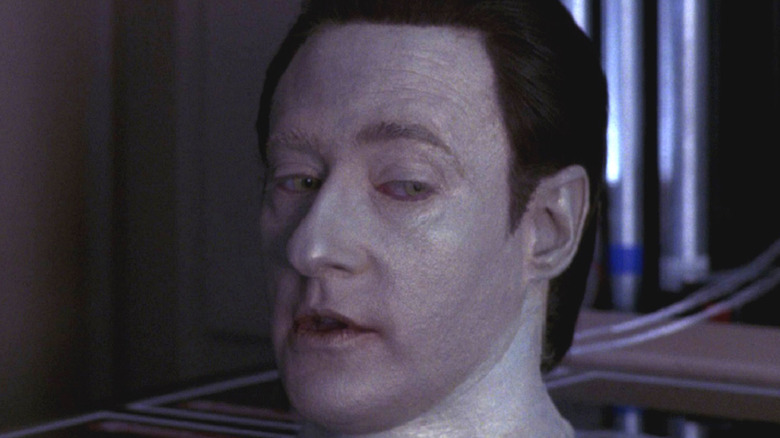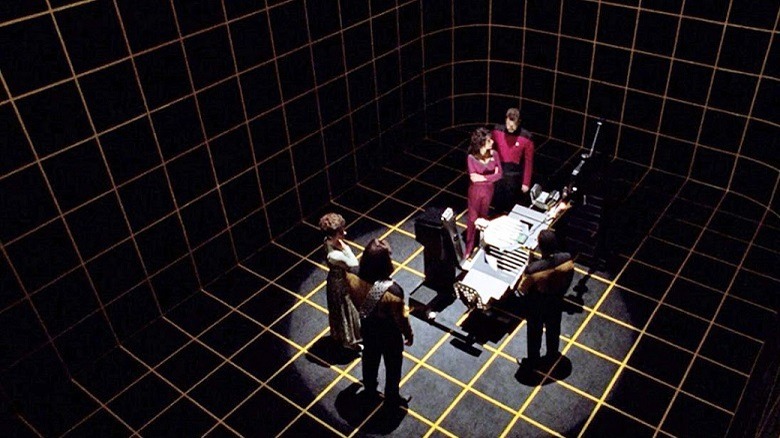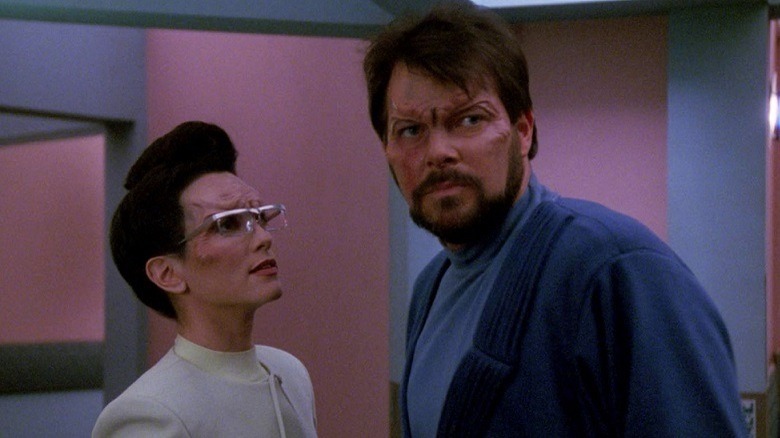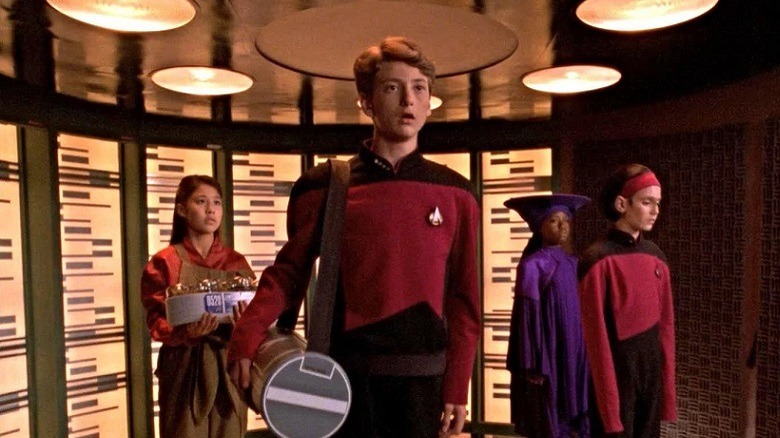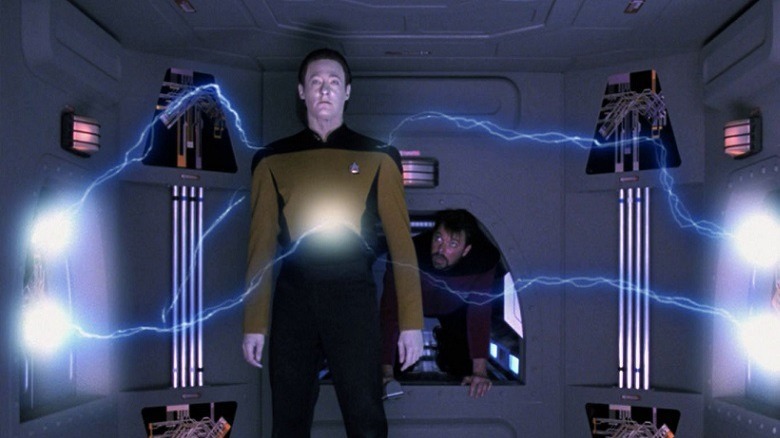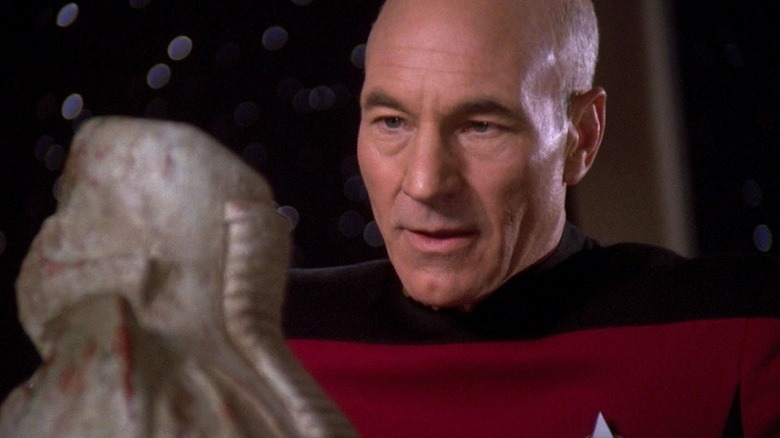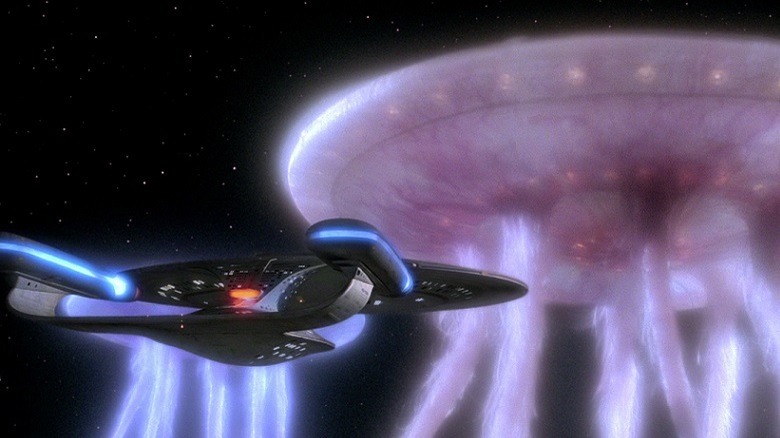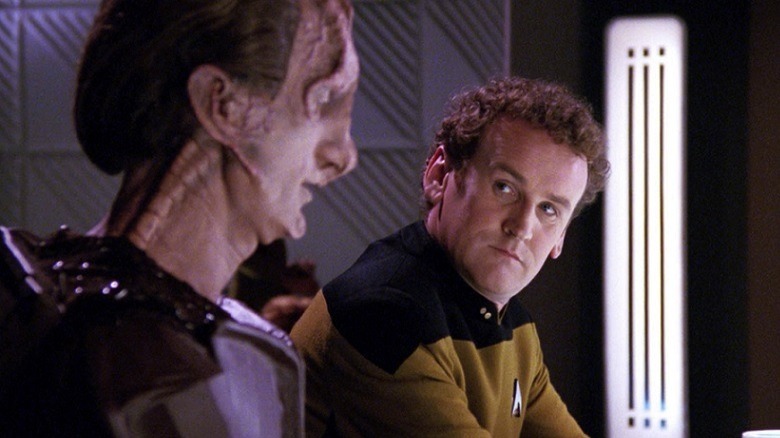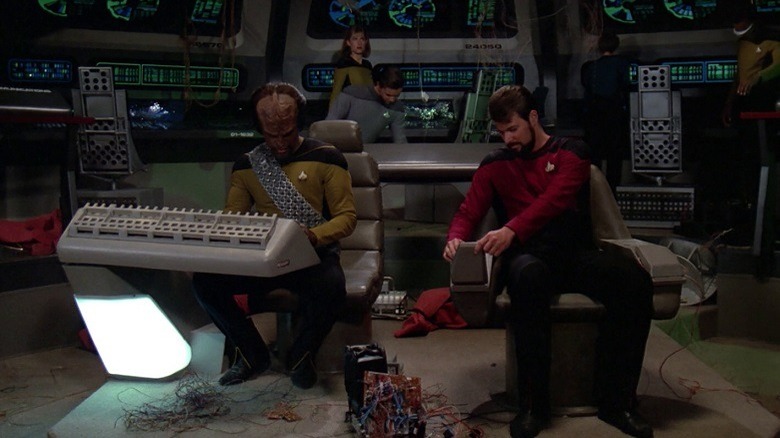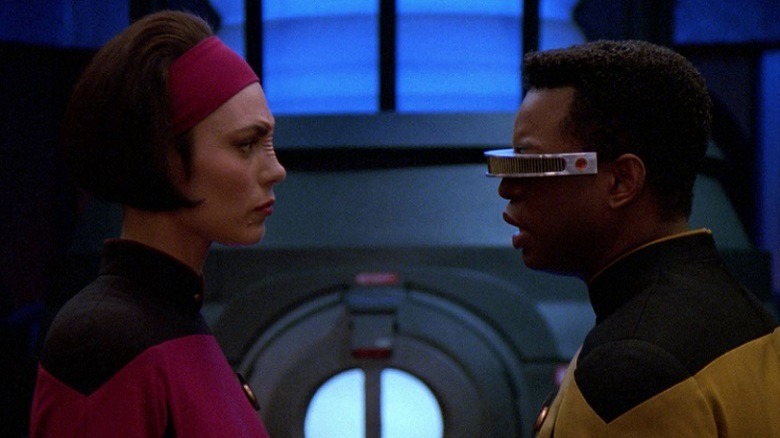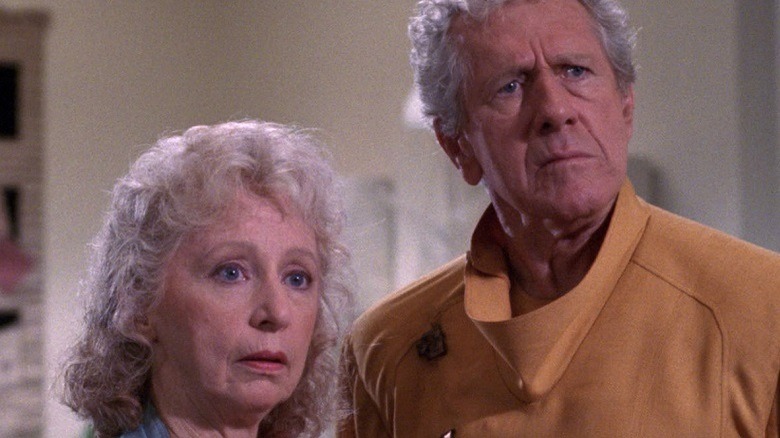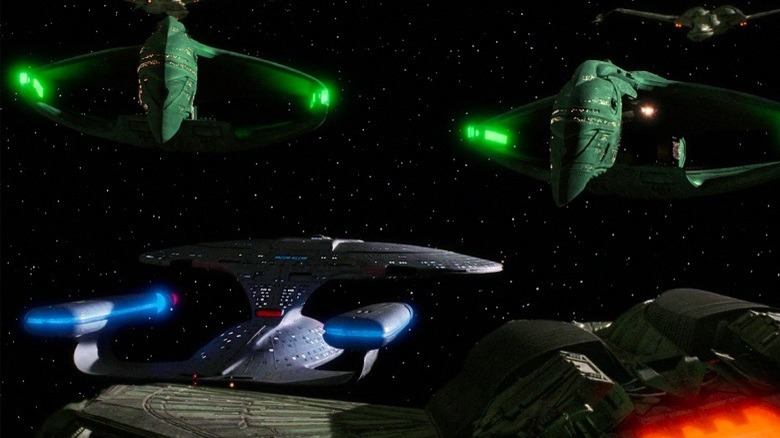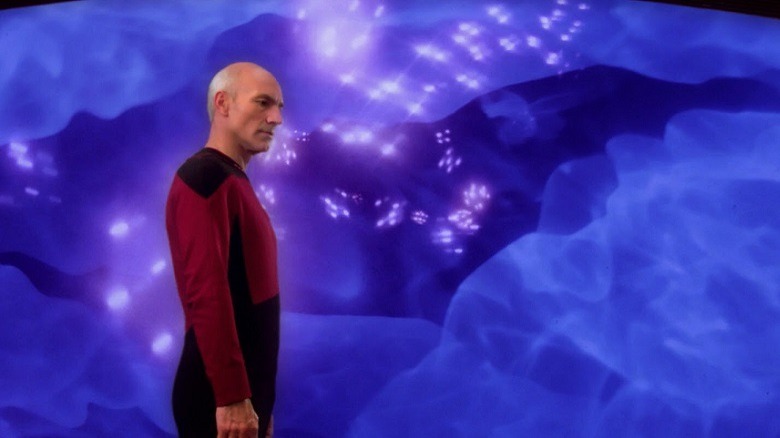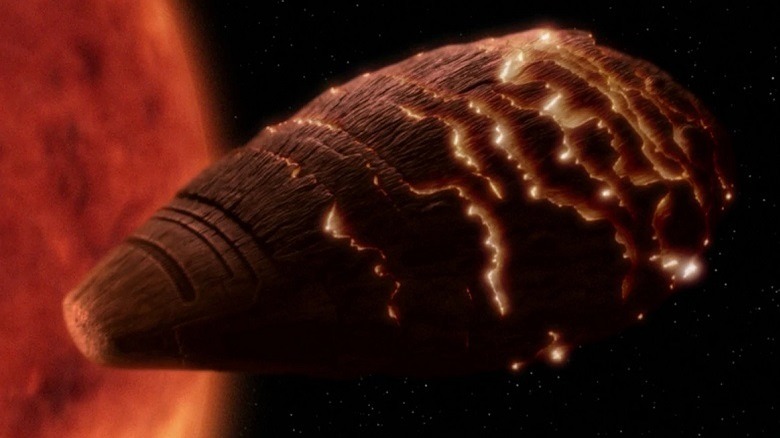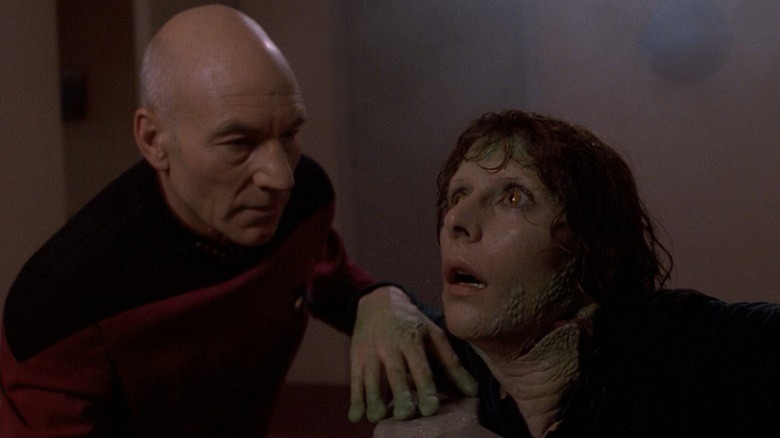14 Underrated Star Trek: The Next Generation Episodes
Running for 178 episodes over seven years, "Star Trek: The Next Generation" deservedly picked up plenty of awards on its ongoing mission, and it's not difficult to pick out episodes that truly stood out as exemplary. There were some absolute stinkers, too like the lazy budget-saving clip show "Shades of Gray," and "Code of Honor" and "Up the Long Ladder," which form a double-bill of offensive cultural insensitivity.
However, there are those stories that often get overlooked, brushed under the space carpet in favor of award-winning episodes — stories that still hold up today but didn't make a particular impact on release. This article is a celebration of the "Next Generation" stories that flew under the radar yet are more than worthy of a rewatch.
To be fair, any episode in which a character delivers the line, "I believe you will also de-evolve into an earlier form of primate — possibly similar to a lemur or pygmy-marmoset" with a straight face deserves to go on almost any list involving "Trek."
Schisms
A variant on the old alien abduction trope, it would be easy to disregard "Schisms" as an episode with a great deal of technobabble, a vague alien threat, and an ambiguous open ending that contributes little to "Star Trek" lore. That would be doing it a massive disservice, though, as this Season 6 episode presents some of the most chilling concepts to the "Next Generation" since we found ourselves in the smoky green interior of a Borg cube.
When crew members of the Enterprise (including an increasingly disheveled Riker) complain of poor sleep, an investigation reveals a sinister truth. The crew is being sedated by an unknown species, abducted, and gruesomely experimented upon. Riker learns that even he is not safe, having had his arm severed and then reattached without his knowledge.
Not only does the episode show the holodeck being used to solve a mystery and not just as an extravagant plaything for bored crew members, but it's also an excellent example of "Star Trek" doing horror well. We have genuinely unnerving alien antagonists working towards an abhorrent goal that's never fully explained, and a helpless crew that, for all the familiar trappings of the Starship they call home, are utterly vulnerable.
First Contact
Sharing a title with the eighth "Star Trek" movie (albeit with fewer Borg) "First Contact" is a gem of a fourth season episode that pulls back the curtain of a rarely-explored Federation activity. Whereas Picard (Patrick Stewart) and his intrepid crew are usually fulfilling the show's premise of seeking out new life and new civilizations, we're rarely treated to the actual logistics of that.
"First Contact" explores the dynamics of the attempts to introduce a new species into the Federation, namely the inhabitants of Malcor III. The Malcorians are on the verge of discovering warp technology, a milestone making them applicable for Federation membership, but Cmdr. Riker (Jonathan Frakes) is injured during an away mission. Taken to an alien hospital Riker finds himself in a predicament that necessitates the hastened involvement of Capt. Picard in the fragile diplomatic process.
With Federation space spanning over ten thousand light years, the first contact procedure must be quite a common one. What may seem like an uninspiring planet-bound episode of dialogue and negotiation provides vital insight into the machinations of the Federation, revealing that, despite their advances in technology, many species are not ready for that final leap to membership.
Rascals
With an idea that seems terrible on paper (the captain and four of his crew are reverted to childhood through a transporter accident), "Rascals" is an episode that's easy to disregard when there are so many good examples of "Trek" being both smart and thought-provoking. However, this episode from the penultimate season of "The Next Generation" reminds us that "Trek" can also be hilarious.
It's a premise that's only as strong as the actors playing the rejuvenated Picard, Keiko, Guinan, and Ro Laren, and they don't disappoint. David Birkin makes for a particularly strong Picard, frustrated by his predicament but impressed at the return of his hair. The actor had already played a Picard before, portraying the captain's nephew René in the 1990 episode "Family".
It's far from perfect, though, which is why it often gets overlooked. It's another episode with dodgy science explained away by the all-too generic "transporter accident" and also reminds us how poorly realized the Ferengi were. Here, they once again make for unconvincing (and easily foiled) villains, but they're almost secondary to the novelty of seeing the humorous interactions between the crew and our transmogrified away team.
Disaster
With a derivative title that must have taken the "Star Trek" writers' room nanoseconds to produce, "Disaster" is an episode you'd be forgiven for forgetting. The episode also features the uninspired use of a random sci-fi jargon generator, with the cause of the titular disaster being a "quantum filament."
Look behind the mediocre facade, and you're presented with a classic episode from Season 5. The episode title is as literal as they come. This is a disaster movie in space, with every single cliché that entails (barring a nun with a guitar). For a rare spatial anomaly that's never been heard of in "Trek" before or after this episode, the Enterprise is unlucky enough to crash into two of the pesky blighters, which damages the ship majorly.
The crew is separated, and the story follows the disparate members in their various predicaments. Ever the family man, Picard finds himself in the uncomfortable position of having to comfort and assist children, and Data (Brent Spiner) is reduced to just a head. It's nothing short of brilliant, and seeing the crew forced to perform duties they're not used to is what makes this episode truly special. I'll bet they'll switch that "Quantum Filament Detector" button to "on" in the future, though.
The Chase
Towards the end of the penultimate season of "Star Trek: The Next Generation," the storylines failed to shine as much as the season before, and the show appeared to be mostly going through the motions. The new kid on the block, "Deep Space Nine" had been released three months before this particular episode and was doing something daring and new with its approach to the franchise.
On paper, "The Chase" seems far from impressive. Archaeological mysteries don't tend to be overly exciting unless they feature fedora-wearing adventurers named after their dog, and, despite the urgency that the title suggests, there isn't a great deal of excitement to be had here, with four competing species racing to solve an ancient mystery. To top it off, the species racing to beat the Federation are well-worn villains at that: Cardassians, Klingons, and Romulans.
What makes this episode memorable — and well worth the watch — is the payoff. For an episode effectively hidden towards the end of the show's run, the final act suggests something so daring that it changes the fabric of "Star Trek" lore and amusingly goes some way to explain why so many "Star Trek" aliens are humanoids with diverse coloring and differently-shaped foreheads.
Encounter at Farpoint
With an uninspiring, workmanlike title, it's a minor Q-style miracle that "Star Trek: The Next Generation" went on to be such an enormous success. With lackluster dialogue, a lack of cast chemistry, and some terrible pacing issues, it seemed like a lazy remake of the original series. History is littered with poor first episodes of amazing seasons (The U.S. "Office" and "Buffy the Vampire Slayer" being notable examples), and this series was no exception to that rule.
The brand spanking new USS Enterprise-D travels to Farpoint Station to open a dialogue with the residents there and discover that the station has a most unusual power supply — one that may seem familiar for cinema fans familiar with Jordan Peele's "Nope."
Past its aforementioned flaws, it's better than you remember. A cameo from DeForest Kelley ("Bones" from the original series) is surprisingly well-done and poignant, and John de Lancie excels in his first appearance as deific, scenery-chewing Q. The new cast would eventually go on to appear way more comfortable in their roles (and in some cases, their outfits), and the show would, of course, go from strength to strength. The character derided by the Washington Post as being a bald crank would become one of the most beloved captains to ever command the USS Enterprise.
The Wounded
It is now canonical that Chief Miles O'Brien is one of the most important people in Star Fleet history, and "The Wounded" is a showcase for the acting talents of actor Colm Meaney.
Until he was thrust into the limelight in "Deep Space Nine," O'Brien wasn't given a great deal to do other than prevent Enterprise crew members from disintegrating in transporter accidents — admittedly, no mean feat. However, this episode, featuring the first appearance of the Cardassians, explores the astronautical Irishman's past.
O'Brien's old captain is targeting Cardassian vessels, threatening the tenuous peace. Miles is tasked with talking him down. Despite the action premise, it's a dialogue-heavy and thought-provoking episode, which is why it often gets overlooked. Despite his cheery facade, Miles harbors old resentments towards the Cardassians, and we see an aspect of his personality never before touched upon. "The Wounded" looks at "Star Trek" conflicts through the post-traumatic stress disorder of (often reluctant) war veterans, a way rarely approached.
The Cardassians would go on to feature heavily in "Star Trek" lore, and this Season 4 episode neatly sets up the animosity that would follow and the duplicitous nature of these inimical extra-terrestrials.
Peak Performance
After a dodgy first season that seemed like a rehash of classic "Star Trek," "Star Trek: The Next Generation" was still finding its feet in Season 2. Ending the second season with the clip show "Shades of Gray" didn't do early "Next Generation" any favors.
To that end, a lot of earlier episodes have been forgotten, but the initial seasons did have some hidden gems. "Peak Performance" sees the Enterprise involved in a bout of war games, pitting Picard against Riker, the latter commanding a rare sighting of a Constellation class ship in the form of the retired USS Hathaway. Of course, those loathsome large-lobed Ferengi turn up to spoil everything, and Will's makeshift crew is forced to save the day.
Featuring some great space battles, it's also worthwhile for its evolution of the relationship between Data and Doctor Pulaski (Beverley Crushers' temporary stand-in whilst she was heading Starfleet Medical, played by Diana Muldaur). Pulaski never really hit it off with viewers due to her abrasive relationship with the crew, but "Peak Performance" developed the chemistry between her and the positron-brained android officer.
The Next Phase
Honestly, who would dare use a transporter in real life? Doctor McCoy's distrust of the matter-transporting technology may have been well-founded, as La Forge (Levar Burton) and Ensign Ro (Michelle Forbes) learn to their cost when their atoms are seemingly scattered across the cosmos while beaming from a Romulan ship.
However, they find themselves on the Enterprise, albeit invisible and with the ability to pass through solid matter. They soon discover that they're not ghosts but are out of phase (hence the half-baked pun of the title) and, despite the inconvenience of being incorporeal, must team up to prevent Romulan saboteurs. Despite the throwaway nature of this episode (another accident caused, identified, and resolved with technobabble), it's a lot of fun, mostly because of the interactions between the rebellious Ro and by-the-book Geordi.
Ro could be a contentious force in the show at times, her rebellious streak jarring when compared to the rest of the strait-laced crew. Here, she's a joy to watch, raising the episode way above the norm and making you realize how underused her character was.
The Survivors
Answering a distress signal from a Federation colony on Rana IV, the Enterprise arrives just a smidgeon too late and finds the planet devastated save for a few acres of land and a single house. An away team dispatched to find survivors locate just a single old couple, Kevin and Rishon Uxbridge (John Anderson and Anne Haney). It soon becomes apparent that neither of them is what they appear.
It would seem that it's next to impossible to travel through a single quadrant of space without encountering a godlike being. It's not just the Q Continuum being all omnipotent and omniscient, there's Trelane, the Caretaker, and hordes of others. This episode is no exception, which is why it may seem unremarkable, but some wonderful standout moments elevate the material. It's more thought-provoking than it first appears, and Picard realizing that he simply doesn't have the right to stand in judgment over a certain decision is an acting masterclass from Patrick Stewart and stalwart character actor John Anderson. And there's a certain appeal of having a godlike being choosing to call himself "Kevin."
The Defector
"The Next Generation" did Cold War episodes well. One noteworthy example is the excellent "Chain of Command," starring the late David Warner. "Defector" does what that episode did with Cardassians with the more established yet equally as enigmatic Romulans.
The Enterprise encounters a Romulan defector (James Sloyan), a clerk armed with knowledge about a forthcoming invasion, who wishes to seek asylum on the Enterprise. Investigation reveals their Romulan visitor's subterfuge. In an act that could threaten war, Picard is forced to choose whether to believe his extravagant claims or not.
The episode simply should not work. It is a mess of plots involving too many crew members, yet at the beating heart of it is a genuine mystery, which makes this episode way more than a sum of its disparate parts. "The Defector" proves there is still much to learn about the Romulans and provides excellent insight into their race and an ending you will never see coming.
Where No One Has Gone Before
In this episode, the Enterprise welcomes belligerent propulsion expert Mr. Kosinski (Stanley Kamel) and his mysterious companion. Transported to the edges of space via warp propulsion tests, the crew has disturbing and strange waking visions. So far, so network-TV-friendly-Event Horizon, but without the eye-gouging and hellish alternate dimensions.
However, in classic "Trek" style, it's another day, another godlike entity. This time, it's Kosinski's aide who is living amongst mortal men. He is the Traveler, a being whose unique powers allow him to transport the Enterprise boldly farther than it has ever gone before.
Initially considered an average episode, over time, it's become more intriguing and of greater significance in "Trek" lore as the first part of the overarching story of Wesley Crusher (Wil Wheaton). The Traveler (Eric Menyuk, who was in the running to play Data) appeared three more times in "Trek" before "recruiting" Wesley, who would ultimately appear as a Traveler in the "Picard" Season 2 finale.
Tin Man
The Enterprise welcomes Elbrun (Harry Groener), a Betazoid whom Riker has reason not to trust. His species' telepathic powers are to be used to encourage a sentient spacecraft (the "Tin Man" of the title) to seek refuge from an imminent supernova. The episode is disregarded by many due to Elbrun's annoying personality. However, with later viewings, you realize the skill of actor Harry Groener, who would go on to portray the charmingly sinister Mayor Wilkins in "Buffy the Vampire Slayer" with equal verve.
He's supposed to be annoying. His character flaws and quirks are a byproduct of his telepathic powers. "Tin Man" also feels very different for an episode of "Star Trek: The Next Generation," and this is probably down to its unusual origins. Rather than being a tale written for "Star Trek," it was adapted from a 1977 Nebula award-winning short story ("Tin Woodman") and was originally quite unrelated to the franchise.
Genesis
Some episodes of "Trek" simply defy belief on first viewing, and "Genesis." one of the very last episodes of "Next Generation," fits into that category. Starfleet officers sometimes have trouble staying on the correct evolutionary path. One minute you have Lt. Tom Parris from "Voyager," breaking the Warp 10 threshold and evolving into a higher life form, and in "Genesis" you have the crew doing the exact opposite and devolving.
It's an annoying virus that's to blame, with Lieutenant Barclay accidentally infecting the rest of the crew while Picard and Data are off dealing with a rogue torpedo. They return to find that the Enterprise is now more menagerie than spacecraft.
Veering between genuine horror and hilariously audacious plotting, "Genesis" is a memorable "Trek" story. It may be a much-derided episode, but there's a gaudy charm to its "we're nearly wrapping up, so what the heck" approach, and the sight of Data's cat Spot transformed into an iguana wearing a pink collar is priceless.Of course, as with all "Trek," all ends well, and a reset returns everybody to normal. Still, it would have been fun seeing the remaining six episodes with an Enterprise staffed entirely by lizards, cave people, and protozoan liquids.
